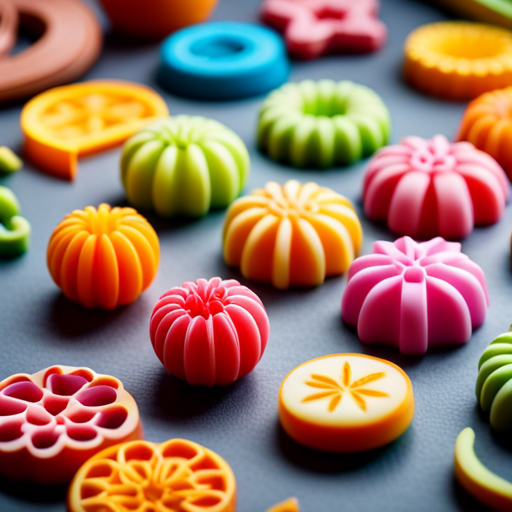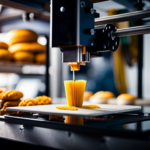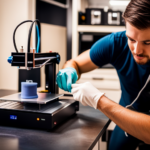What if desserts could be customized and created with intricate designs using 3D printing technology?
In this article, we delve into the fascinating world of 3D printed sweets and confections.
From the evolution of 3D printed confections to innovative techniques and the fusion of culinary creativity with technology, we explore the limitless possibilities of edible art.
Join us as we uncover the future of personalized and visually stunning desserts.
The Evolution of 3D Printed Confections
As 3D printing technology continues to advance, the evolution of 3D printed confections has paved the way for innovative and intricate designs in the world of sweets and confections. One of the most exciting developments is the ability to create stunning 3D printed chocolate. This technology allows chocolatiers to craft elaborate and delicate designs that were once impossible to achieve by hand. The precision and intricacy of 3D printing enable the production of chocolate sculptures and decorations that captivate the eye and delight the palate.
Furthermore, 3D printing has revolutionized the creation of sugar sculptures. Intricately detailed and delicate sugar sculptures are now achievable through 3D printing, allowing pastry chefs and confectioners to push the boundaries of their art. The ability to produce complex and ornate sugar sculptures with 3D printing technology has opened up a world of creativity and possibilities in the realm of confectionery.
Innovative Techniques in 3D Dessert Printing
Innovative techniques in 3D dessert printing are revolutionizing the creation of intricate and visually stunning confections. Flavor infusion is one of the key advancements in 3D dessert printing, allowing for the incorporation of unique and complex flavor profiles into confections. This technique involves infusing the confectionery material with various flavors, such as fruit essences, floral notes, or even spicy undertones, during the printing process. As a result, 3D printed desserts can offer a multi-dimensional sensory experience, elevating the enjoyment of the sweet treats.
Texture manipulation is another groundbreaking technique in 3D dessert printing. By precisely controlling the deposition and layering of the confectionery material, chefs and confectioners can create desserts with diverse textures. From smooth and creamy to crunchy and airy, the ability to manipulate texture adds a new dimension to the art of dessert making. This technique allows for the creation of desserts that not only delight the taste buds but also engage the sense of touch, offering a truly immersive culinary experience.
As 3D dessert printing continues to evolve, these innovative techniques are paving the way for new possibilities in the world of confectionery artistry.
Culinary Creativity Meets Technology
With the integration of 3D printing technology, culinary creativity is reaching new heights in the realm of confectionery artistry. Flavor infusion and texture manipulation, discussed previously, are just the beginning of how technology is enhancing the creation of visually stunning and multi-sensory desserts. Fusion cuisine, a culinary trend that blends different cultural and regional culinary traditions, is now being revolutionized by technology through 3D printing. This allows chefs to experiment with unconventional combinations and present truly unique flavor experiences to their patrons. Culinary design has also been transformed by 3D printing, enabling pastry chefs to craft intricate and elaborate dessert decorations that were once only imaginable. This union of culinary artistry and technology has opened up a world of possibilities, pushing the boundaries of traditional dessert making. Below is an illustrative representation of the impact of 3D printing on the culinary world:
| Aspects of Impact | Description |
|---|---|
| Fusion Cuisine | Technology allows for the creation of unconventional flavor combinations. |
| Culinary Design | 3D printing enables intricate and elaborate dessert decorations. |
| Multi-Sensory Experience | Visually stunning and unique flavor experiences are made possible. |
Customizable Confections: The Personalized Touch
The integration of 3D printing technology has paved the way for customizable confections, offering a personalized touch that enhances the multi-sensory experience of culinary artistry. This personalized approach allows for the creation of confections that cater to individual preferences, making them truly unique and memorable.
Here are four ways in which customizable confections are elevating the experience of sweet treats:
-
Personalized Designs: With 3D printing, confectioners can craft intricate and personalized designs, ranging from custom shapes to intricate patterns, allowing for a level of detail and precision that was previously unattainable.
-
Tailored Flavors: The ability to customize flavors opens up a world of possibilities, enabling the creation of confections that cater to specific tastes and dietary requirements, such as sugar-free, vegan, or gluten-free options.
-
Unique Combinations: Through 3D printing, confectioners can experiment with unconventional flavor combinations, creating confections that tantalize the taste buds with unexpected and delightful pairings.
-
Personalized Messages: Whether it’s a special occasion or a corporate event, 3D printed confections can feature personalized messages, adding a thoughtful and unique touch to the sweet experience.
Exploring the Future of Edible Art
As the field of confectionery continues to evolve, the future of edible art holds immense potential for creative expression and culinary innovation. The future possibilities for edible art are vast, with advancements in technology and culinary techniques opening up new avenues for artistic expression.
With the emergence of 3D printing in the confectionery world, the art of creating edible masterpieces is undergoing a transformation. The ability to intricately design and produce confections with precision and detail has expanded the scope of what can be achieved in edible art.
Artistic expression in the realm of edible creations is poised to take on new dimensions as chefs and confectioners explore innovative ways to blend art and food. The fusion of traditional confectionery skills with modern technology is paving the way for extraordinary edible artworks that were once unimaginable.
This convergence of artistry and culinary expertise promises to captivate not only the taste buds but also the eyes, as confectioners push the boundaries of what is possible in the world of edible art.
Frequently Asked Questions
What Are the Potential Health Risks Associated With Consuming 3D Printed Sweets and Confections?
Potential risks associated with consuming 3D printed sweets and confections include food safety concerns such as contamination, allergen control, and regulatory implications. Consumer awareness of the manufacturing process and ingredient control is essential.
Can 3D Printed Confections Be Customized to Accommodate Dietary Restrictions, Such as Gluten-Free or Vegan Options?
Customization options in 3D printed confections allow for allergen-friendly designs such as gluten-free or vegan options. Innovative applications of this technology provide opportunities for culinary creativity, catering to diverse dietary restrictions and preferences.
How Does the Taste and Texture of 3D Printed Sweets Compare to Traditionally Made Confections?
The taste comparison and texture analysis of 3D printed sweets versus traditionally made confections reveal nuanced differences. 3D printed sweets often boast a precise, smooth texture and unique flavor delivery, while traditional confections offer a more organic, artisanal experience.
Are There Any Environmental Concerns or Sustainability Issues Related to the Use of 3D Printing in the Dessert Industry?
Environmental impact and sustainability concerns are prevalent in the dessert industry’s use of 3D printing. The production process, materials, and energy consumption raise questions about the long-term effects on the environment and the industry’s sustainability.
What Are the Limitations and Challenges of 3D Printing When It Comes to Creating Complex and Intricate Dessert Designs?
Creating intricate dessert designs through 3D printing presents challenges in achieving structural stability, maintaining printing resolution, and ensuring material compatibility. It demands a balance of artistic creativity with technical precision, pushing the boundaries of innovation.
Conclusion
In conclusion, the world of 3D printed sweets and confections is a delightful blend of culinary innovation and technological advancement.
As we continue to explore the possibilities of edible art, the potential for customizable confections and personalized desserts is truly limitless.
With innovative techniques and a touch of creativity, the future of 3D printed desserts is sure to satisfy our sweet tooth and leave us craving for more.
Embrace the evolution of confectionery and indulge in the delectable world of 3D printed treats.


